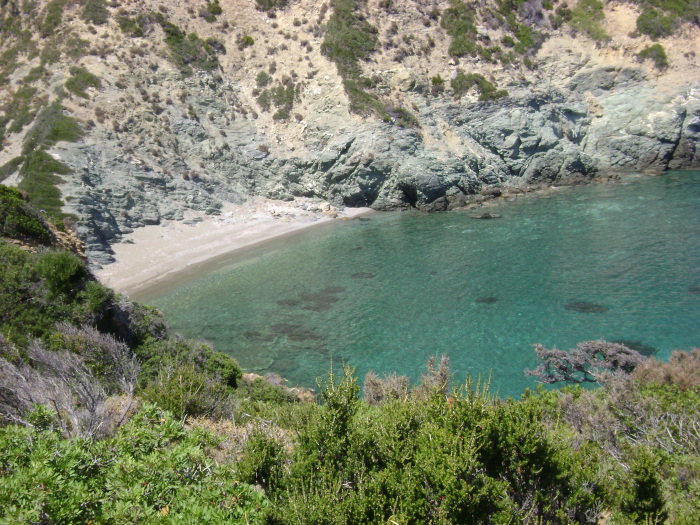With an area of 25 sq. km, Kyra Panagia is the largest of the hermitages. Its hills range between 169 and 299 meters. It was the ancient Alonissos, later Pelagonisi.
Today the island is the property of the Monastery of the Great Lavra of Mount Athos, and owes its name to the monastery of the same name.
This story began in 963 AD, when Saint Athanasios bought the island from the Byzantine rulers in Constantinople as a share of Mount Athos, to supply the monasteries there with food such as meat, honey, oil and wheat.
As is well known, the entry of women was prohibited on Mount Athos since then, some of you may not know that not even a female animal was allowed on Athos and so the monks relied on metochia for their meat needs. This is how goat breeding began in Kyra Panagia and has not stopped until today, when the island is leased by the Monastery of Agia Lavra to local breeders to graze their herds.
On the southeast side of the island is the monastery, built in 1100 AD. Until 1984 there was still a monk here. The monastery overlooks the sea from above and looks more like a small fortress, reminiscent of the times when pirates ravaged the area. Its natural harbor is exposed to the weather and boats can only approach it in good weather conditions.
The buildings of the monastery, modest but impressive, were renovated in 1992 with a donation from the Potamianou family, ready to once again host monks who want to come here. In the monastery there are still the old lyotrivi and the old flour mill and it is interesting to see them. From up here, on days with good visibility, you have a wonderful view of the opposite islet of Jura and the rock islands of Pappus and Grammiza in front of it and further to the islet of Piperi. If the weather is good, you can also see the flat mass of Psathoura emerging from the sea in the background.
On the island there are many olive trees that once supplied the community of the monastery with oil and olives. Today no one takes care of them as only a few gather. The crops in the fertile plains of the island are also abandoned. There are many springs on the island, which is why they could have domesticated animals here. The territory of Kyra Panagia is mainly covered by holly, maquis and hydrangea.
Traces of early settlement
Kyra Panagia has two large natural bays: Agios Petros to the west and Planetis to the east of the island. In the sheltered bay of Agios Petros, boats take refuge when the wind blows from the north. The ships of the Byzantine sailors were also anchored here and one of them anchored permanently at the bottom of the bay, a wreck that still remains unexplored by archaeologists.
Kyra Panagia was the center of the deserts in ancient times, which were not as deserted as they are today. Remains of Neolithic settlements have been found on the island and thus Kyra Panagia is included among the Aegean islands that were settled from a very early age (around 6000 BC). Ancient fragments were found opposite the islet of Melissa in the bay of Agios Petros. An entire ancient city was probably established here, as evidenced by the remains of walls discovered on the shore of the bay. Surely the findings have a long story to tell the archaeologists who will study them. The island was continuously inhabited until the classical era, but it became known during the conflict between the Athenians and Philip. From the 5th BC century belonged to Athens. In 351 BC the Peparithian robber Sostratos captured it and made it his stronghold. Shortly before 346 BC Philip captured the island and expelled Sostratos. The Athenians, however, to whom the island belonged, complained and Philip agreed to sell it to them. Despite all this, the Athenians did not accept and then the orator Hegisippos delivered his speech "About Alonissos", from which only excerpts are preserved. You wrongly attribute the speech to Demosthenes, who wrote another speech "About Alonissos", which was lost.
To the south of the bay the plain of Agios Petros descends from the mountain full of olive trees and at its base there are remains of an old monastery.
The bay of Planetis in the east is one of the largest natural harbors in the Mediterranean. Its opening is about 80 meters wide and then divides into a western and a southern section, each a few hundred meters wide. Arriving by boat at Planitis, one wonders how, with such an ideal natural harbor, no settlement has developed here. The fact that the island belongs to Mount Athos is apparently the reason it was not inhabited in recent history. This was fortunate for the nature that remained undisturbed (if we exclude overgrazing), and for today's visitor who can enjoy an authentic Aegean natural landscape.
Editor: Fotini Anastasopoulou
